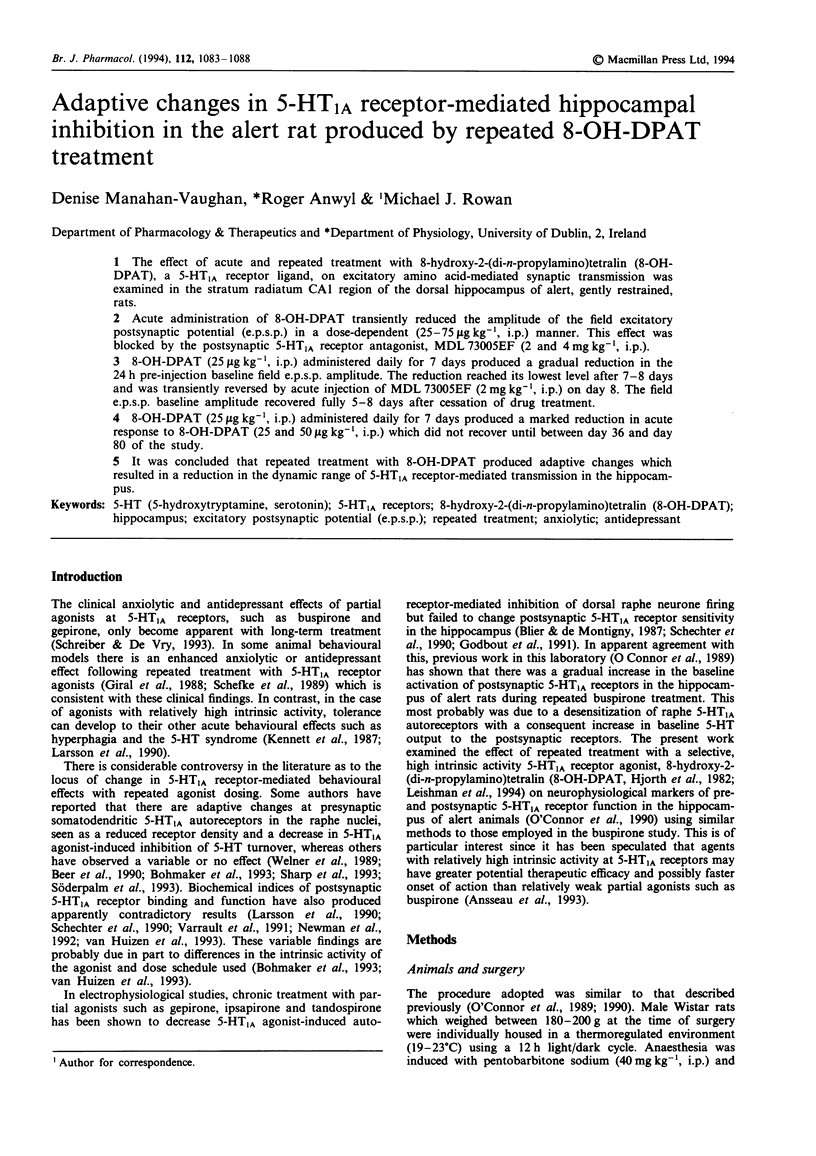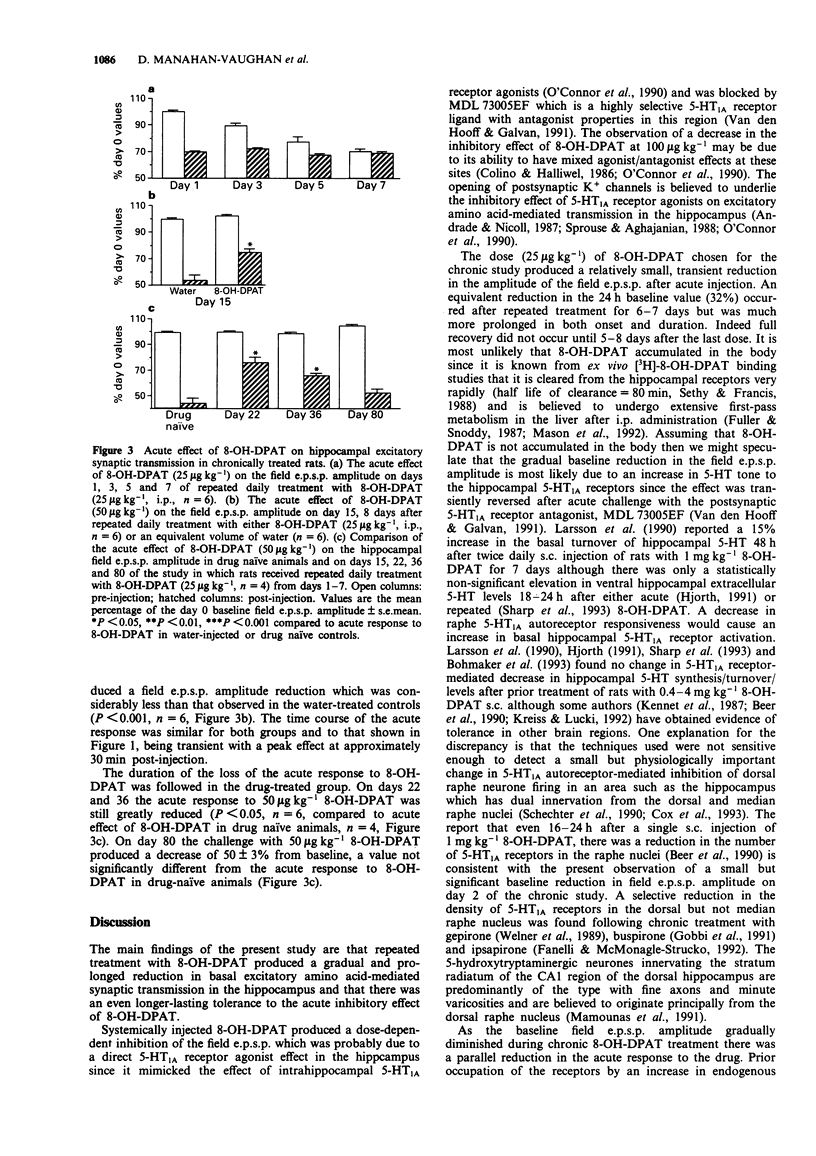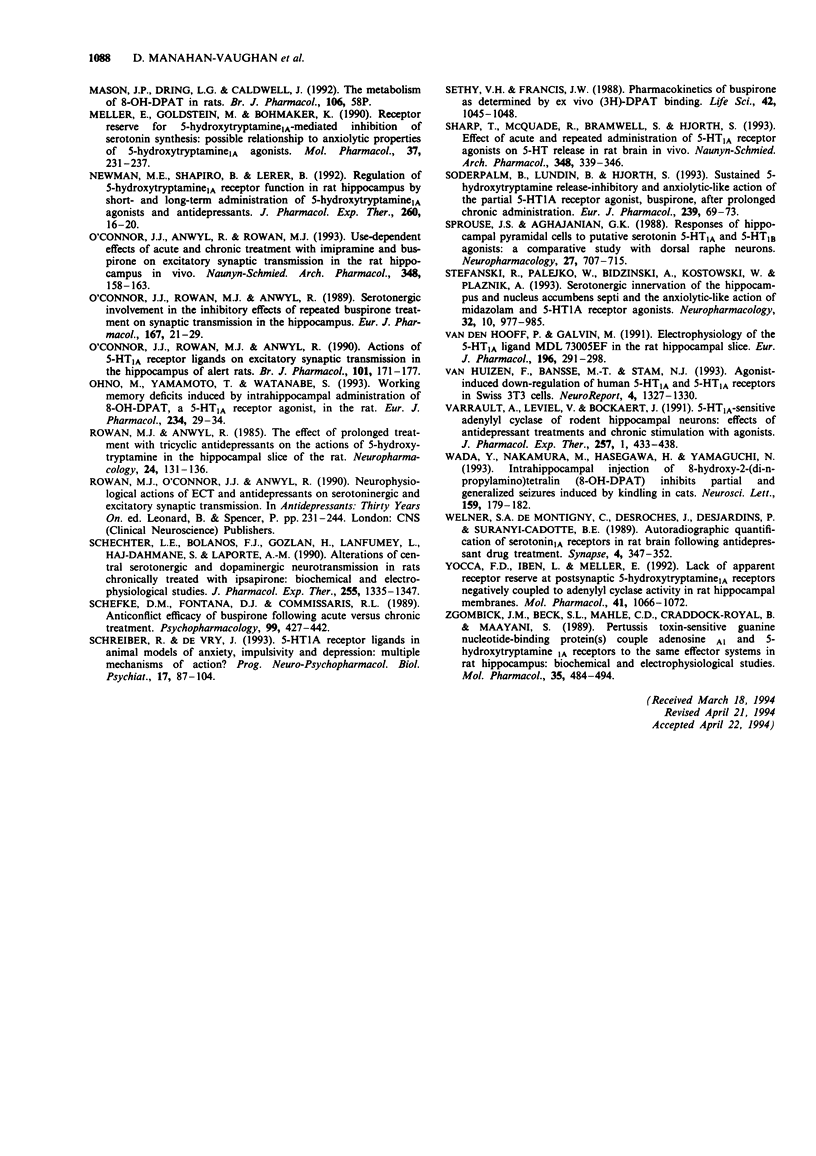Abstract
1. The effect of acute and repeated treatment with 8-hydroxy-2-(di-n-propylamino)tetralin (8-OH-DPAT), a 5-HT1A receptor ligand, on excitatory amino acid-mediated synaptic transmission was examined in the stratum radiatum CA1 region of the dorsal hippocampus of alert, gently restrained, rats. 2. Acute administration of 8-OH-DPAT transiently reduced the amplitude of the field excitatory postsynaptic potential (e.p.s.p.) in a dose-dependent (25-75 micrograms kg-1, i.p.) manner. This effect was blocked by the postsynaptic 5-HT1A receptor antagonist, MDL 73005EF (2 and 4 mg kg-1, i.p.). 3. 8-OH-DPAT (25 micrograms kg-1, i.p.) administered daily for 7 days produced a gradual reduction in the 24 h pre-injection baseline field e.p.s.p. amplitude. The reduction reached its lowest level after 7-8 days and was transiently reversed by acute injection of MDL 73005EF (2 mg kg-1, i.p.) on day 8. The field e.p.s.p. baseline amplitude recovered fully 5-8 days after cessation of drug treatment. 4. 8-OH-DPAT (25 micrograms kg-1, i.p.) administered daily for 7 days produced a marked reduction in acute response to 8-OH-DPAT (25 and 50 micrograms kg-1, i.p.) which did not recover until between day 36 and day 80 of the study. 5. It was concluded that repeated treatment with 8-OH-DPAT produced adaptive changes which resulted in a reduction in the dynamic range of 5-HT1A receptor-mediated transmission in the hippocampus.
Full text
PDF





Selected References
These references are in PubMed. This may not be the complete list of references from this article.
- Andrade R., Malenka R. C., Nicoll R. A. A G protein couples serotonin and GABAB receptors to the same channels in hippocampus. Science. 1986 Dec 5;234(4781):1261–1265. doi: 10.1126/science.2430334. [DOI] [PubMed] [Google Scholar]
- Andrade R., Nicoll R. A. Pharmacologically distinct actions of serotonin on single pyramidal neurones of the rat hippocampus recorded in vitro. J Physiol. 1987 Dec;394:99–124. doi: 10.1113/jphysiol.1987.sp016862. [DOI] [PMC free article] [PubMed] [Google Scholar]
- Beer M., Kennett G. A., Curzon G. A single dose of 8-OH-DPAT reduces raphe binding of [3H]8-OH-DPAT and increases the effect of raphe stimulation on 5-HT metabolism. Eur J Pharmacol. 1990 Mar 20;178(2):179–187. doi: 10.1016/0014-2999(90)90473-j. [DOI] [PubMed] [Google Scholar]
- Blier P., Lista A., De Montigny C. Differential properties of pre- and postsynaptic 5-hydroxytryptamine1A receptors in the dorsal raphe and hippocampus: I. Effect of spiperone. J Pharmacol Exp Ther. 1993 Apr;265(1):7–15. [PubMed] [Google Scholar]
- Blier P., de Montigny C. Modification of 5-HT neuron properties by sustained administration of the 5-HT1A agonist gepirone: electrophysiological studies in the rat brain. Synapse. 1987;1(5):470–480. doi: 10.1002/syn.890010511. [DOI] [PubMed] [Google Scholar]
- Bohmaker K., Eison A. S., Yocca F. D., Meller E. Comparative effects of chronic 8-OH-DPAT, gepirone and ipsapirone treatment on the sensitivity of somatodendritic 5-HT1A autoreceptors. Neuropharmacology. 1993 Jun;32(6):527–534. doi: 10.1016/0028-3908(93)90048-8. [DOI] [PubMed] [Google Scholar]
- Colino A., Halliwell J. V. 8-OH-DPAT is a strong antagonist of 5-HT action in rat hippocampus. Eur J Pharmacol. 1986 Oct 14;130(1-2):151–152. doi: 10.1016/0014-2999(86)90196-2. [DOI] [PubMed] [Google Scholar]
- Cox R. F., Meller E., Waszczak B. L. Electrophysiological evidence for a large receptor reserve for inhibition of dorsal raphe neuronal firing by 5-HT1A agonists. Synapse. 1993 Aug;14(4):297–304. doi: 10.1002/syn.890140407. [DOI] [PubMed] [Google Scholar]
- Fanelli R. J., McMonagle-Strucko K. Alteration of 5-HT1A receptor binding sites following chronic treatment with ipsapirone measured by quantitative autoradiography. Synapse. 1992 Sep;12(1):75–81. doi: 10.1002/syn.890120109. [DOI] [PubMed] [Google Scholar]
- Fuller R. W., Snoddy H. D. Influence of route of administration on potency of the selective 5HT-1A agonist, 8-hydroxy-2-(di-n-propylamino)tetralin, in rats. Res Commun Chem Pathol Pharmacol. 1987 Dec;58(3):409–412. [PubMed] [Google Scholar]
- Giral P., Martin P., Soubrié P., Simon P. Reversal of helpless behavior in rats by putative 5-HT1A agonists. Biol Psychiatry. 1988 Feb 1;23(3):237–242. doi: 10.1016/0006-3223(88)90034-0. [DOI] [PubMed] [Google Scholar]
- Gobbi M., Cavanus S., Miari A., Mennini T. Effect of acute and chronic administration of buspirone on serotonin and benzodiazepine receptor subtypes in the rat brain: an autoradiographic study. Neuropharmacology. 1991 Apr;30(4):313–321. doi: 10.1016/0028-3908(91)90055-g. [DOI] [PubMed] [Google Scholar]
- Godbout R., Chaput Y., Blier P., de Montigny C. Tandospirone and its metabolite, 1-(2-pyrimidinyl)-piperazine--I. Effects of acute and long-term administration of tandospirone on serotonin neurotransmission. Neuropharmacology. 1991 Jul;30(7):679–690. doi: 10.1016/0028-3908(91)90175-b. [DOI] [PubMed] [Google Scholar]
- Hjorth S. Single-dose 8-OH-DPAT pretreatment does not induce tachyphylaxis to the 5-HT release-reducing effect of 5-HT1A autoreceptor agonists. Eur J Pharmacol. 1991 Jun 25;199(2):237–242. doi: 10.1016/0014-2999(91)90463-z. [DOI] [PubMed] [Google Scholar]
- Kennett G. A., Marcou M., Dourish C. T., Curzon G. Single administration of 5-HT1A agonists decreases 5-HT1A presynaptic, but not postsynaptic receptor-mediated responses: relationship to antidepressant-like action. Eur J Pharmacol. 1987 Jun 12;138(1):53–60. doi: 10.1016/0014-2999(87)90336-0. [DOI] [PubMed] [Google Scholar]
- Kreiss D. S., Lucki I. Desensitization of 5-HT1A autoreceptors by chronic administration of 8-OH-DPAT. Neuropharmacology. 1992 Oct;31(10):1073–1076. doi: 10.1016/0028-3908(92)90110-b. [DOI] [PubMed] [Google Scholar]
- Larsson L. G., Rényi L., Ross S. B., Svensson B., Angeby-Möller K. Different effects on the responses of functional pre- and postsynaptic 5-HT1A receptors by repeated treatment of rats with the 5-HT1A receptor agonist 8-OH-DPAT. Neuropharmacology. 1990 Feb;29(2):85–91. doi: 10.1016/0028-3908(90)90047-u. [DOI] [PubMed] [Google Scholar]
- Leishman D. J., Boeijinga P. H., Galvan M. Differential effects of centrally-active antihypertensives on 5-HT1A receptors in rat dorso-lateral septum, rat hippocampus and guinea-pig hippocampus. Br J Pharmacol. 1994 Jan;111(1):318–324. doi: 10.1111/j.1476-5381.1994.tb14062.x. [DOI] [PMC free article] [PubMed] [Google Scholar]
- Leung L. W. Orthodromic activation of hippocampal CA1 region of the rat. Brain Res. 1979 Oct 26;176(1):49–63. doi: 10.1016/0006-8993(79)90869-2. [DOI] [PubMed] [Google Scholar]
- Mamounas L. A., Mullen C. A., O'Hearn E., Molliver M. E. Dual serotoninergic projections to forebrain in the rat: morphologically distinct 5-HT axon terminals exhibit differential vulnerability to neurotoxic amphetamine derivatives. J Comp Neurol. 1991 Dec 15;314(3):558–586. doi: 10.1002/cne.903140312. [DOI] [PubMed] [Google Scholar]
- Meller E., Goldstein M., Bohmaker K. Receptor reserve for 5-hydroxytryptamine1A-mediated inhibition of serotonin synthesis: possible relationship to anxiolytic properties of 5-hydroxytryptamine1A agonists. Mol Pharmacol. 1990 Feb;37(2):231–237. [PubMed] [Google Scholar]
- Newman M. E., Shapira B., Lerer B. Regulation of 5-hydroxytryptamine1A receptor function in rat hippocampus by short- and long-term administration of 5-hydroxytryptamine1A agonist and antidepressants. J Pharmacol Exp Ther. 1992 Jan;260(1):16–20. [PubMed] [Google Scholar]
- O'Connor J. J., Rowan M. J., Anwyl R. Actions of 5-HT1 ligands on excitatory synaptic transmission in the hippocampus of alert rats. Br J Pharmacol. 1990 Sep;101(1):171–177. doi: 10.1111/j.1476-5381.1990.tb12108.x. [DOI] [PMC free article] [PubMed] [Google Scholar]
- O'Connor J. J., Rowan M. J., Anwyl R. Serotonergic involvement in the inhibitory effects of repeated buspirone treatment on synaptic transmission in the hippocampus. Eur J Pharmacol. 1989 Aug 11;167(1):21–29. doi: 10.1016/0014-2999(89)90743-7. [DOI] [PubMed] [Google Scholar]
- O'Connor J. J., Rowan M. J., Anwyl R. Use-dependent effects of acute and chronic treatment with imipramine and buspirone on excitatory synaptic transmission in the rat hippocampus in vivo. Naunyn Schmiedebergs Arch Pharmacol. 1993 Aug;348(2):158–163. doi: 10.1007/BF00164793. [DOI] [PubMed] [Google Scholar]
- Ohno M., Yamamoto T., Watanabe S. Working memory deficits induced by intrahippocampal administration of 8-OH-DPAT, a 5-HT1A receptor agonist, in the rat. Eur J Pharmacol. 1993 Mar 30;234(1):29–34. doi: 10.1016/0014-2999(93)90702-j. [DOI] [PubMed] [Google Scholar]
- Rowan M. J., Anwyl R. The effect of prolonged treatment with tricyclic antidepressants on the actions of 5-hydroxytryptamine in the hippocampal slice of the rat. Neuropharmacology. 1985 Feb;24(2):131–137. doi: 10.1016/0028-3908(85)90172-8. [DOI] [PubMed] [Google Scholar]
- Schechter L. E., Bolaños F. J., Gozlan H., Lanfumey L., Haj-Dahmane S., Laporte A. M., Fattaccini C. M., Hamon M. Alterations of central serotoninergic and dopaminergic neurotransmission in rats chronically treated with ipsapirone: biochemical and electrophysiological studies. J Pharmacol Exp Ther. 1990 Dec;255(3):1335–1347. [PubMed] [Google Scholar]
- Schefke D. M., Fontana D. J., Commissaris R. L. Anti-conflict efficacy of buspirone following acute versus chronic treatment. Psychopharmacology (Berl) 1989;99(3):427–429. doi: 10.1007/BF00445572. [DOI] [PubMed] [Google Scholar]
- Schreiber R., De Vry J. 5-HT1A receptor ligands in animal models of anxiety, impulsivity and depression: multiple mechanisms of action? Prog Neuropsychopharmacol Biol Psychiatry. 1993 Jan;17(1):87–104. doi: 10.1016/0278-5846(93)90034-p. [DOI] [PubMed] [Google Scholar]
- Sethy V. H., Francis J. W. Pharmacokinetics of buspirone as determined by ex vivo (3H)-DPAT binding. Life Sci. 1988;42(10):1045–1048. doi: 10.1016/0024-3205(88)90559-0. [DOI] [PubMed] [Google Scholar]
- Sharp T., McQuade R., Bramwell S., Hjorth S. Effect of acute and repeated administration of 5-HT1A receptor agonists on 5-HT release in rat brain in vivo. Naunyn Schmiedebergs Arch Pharmacol. 1993 Oct;348(4):339–346. doi: 10.1007/BF00171331. [DOI] [PubMed] [Google Scholar]
- Sprouse J. S., Aghajanian G. K. Responses of hippocampal pyramidal cells to putative serotonin 5-HT1A and 5-HT1B agonists: a comparative study with dorsal raphe neurons. Neuropharmacology. 1988 Jul;27(7):707–715. doi: 10.1016/0028-3908(88)90079-2. [DOI] [PubMed] [Google Scholar]
- Stefański R., Pałejko W., Bidziński A., Kostowski W., Płaźnik A. Serotonergic innervation of the hippocampus and nucleus accumbens septi and the anxiolytic-like action of midazolam and 5-HT1A receptor agonists. Neuropharmacology. 1993 Oct;32(10):977–985. doi: 10.1016/0028-3908(93)90062-8. [DOI] [PubMed] [Google Scholar]
- Söderpalm B., Lundin B., Hjorth S. Sustained 5-hydroxytryptamine release-inhibitory and anxiolytic-like action of the partial 5-HT1A receptor agonist, buspirone, after prolonged chronic administration. Eur J Pharmacol. 1993 Aug 3;239(1-3):69–73. doi: 10.1016/0014-2999(93)90977-p. [DOI] [PubMed] [Google Scholar]
- Van den Hooff P., Galvan M. Electrophysiology of the 5-HT1A ligand MDL 73005EF in the rat hippocampal slice. Eur J Pharmacol. 1991 Apr 24;196(3):291–298. doi: 10.1016/0014-2999(91)90442-s. [DOI] [PubMed] [Google Scholar]
- Varrault A., Leviel V., Bockaert J. 5-HT1A-sensitive adenylyl cyclase of rodent hippocampal neurons: effects of antidepressant treatments and chronic stimulation with agonists. J Pharmacol Exp Ther. 1991 Apr;257(1):433–438. [PubMed] [Google Scholar]
- Wada Y., Nakamura M., Hasegawa H., Yamaguchi N. Intra-hippocampal injection of 8-hydroxy-2-(di-n-propylamino)tetralin (8-OH-DPAT) inhibits partial and generalized seizures induced by kindling stimulation in cats. Neurosci Lett. 1993 Sep 3;159(1-2):179–182. doi: 10.1016/0304-3940(93)90828-9. [DOI] [PubMed] [Google Scholar]
- Welner S. A., De Montigny C., Desroches J., Desjardins P., Suranyi-Cadotte B. E. Autoradiographic quantification of serotonin1A receptors in rat brain following antidepressant drug treatment. Synapse. 1989;4(4):347–352. doi: 10.1002/syn.890040410. [DOI] [PubMed] [Google Scholar]
- Yocca F. D., Iben L., Meller E. Lack of apparent receptor reserve at postsynaptic 5-hydroxytryptamine1A receptors negatively coupled to adenylyl cyclase activity in rat hippocampal membranes. Mol Pharmacol. 1992 Jun;41(6):1066–1072. [PubMed] [Google Scholar]
- Zgombick J. M., Beck S. G., Mahle C. D., Craddock-Royal B., Maayani S. Pertussis toxin-sensitive guanine nucleotide-binding protein(S) couple adenosine A1 and 5-hydroxytryptamine1A receptors to the same effector systems in rat hippocampus: biochemical and electrophysiological studies. Mol Pharmacol. 1989 Apr;35(4):484–494. [PubMed] [Google Scholar]
- van Huizen F., Bansse M. T., Stam N. J. Agonist-induced down-regulation of human 5-HT1A and 5-HT2 receptors in Swiss 3T3 cells. Neuroreport. 1993 Sep 30;4(12):1327–1330. doi: 10.1097/00001756-199309150-00010. [DOI] [PubMed] [Google Scholar]


